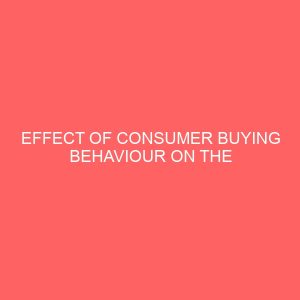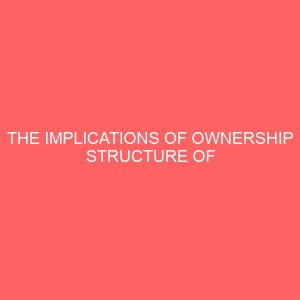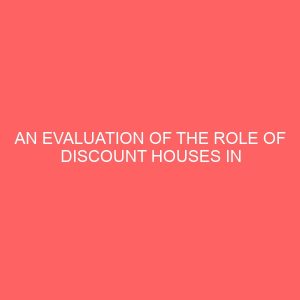Description
CHAPTER ONE
BACKGROUND OF THE STUDY
1.1 INTRODUCTION:
Every day consumers buy things. Consumers exchange their money for goods and services, for their own use and for the use of their families: Consumers choose things they think will meet their needs on a day-to-day basis, and they occasionally make buying decisions which will affect their lives for years to come. At the same time, consumers make decisions about disposing of worn-out or used-up possessions. All these decisions and exchanges have implications for ourselves, our families, our friends, the environment, and the businesses we buy from, the employees of those businesses, and so on. And that is why Blackwell et al. (2001) asserts that consumer behaviour is the activities people undertake when obtaining, consuming and disposing of productsand services.
While lamenting the critical state of insurance marketing in Nigeria, Osoka (1992) highlights the prevalence of confusion among insurance marketers between selling and marketing. According to the author, while selling is concerned with creating demand for the products that have already been decided, marketing is directed towards identifying the needs and wants of consumers and planning to satisfy those needs. Hence, in this context, the necessity of understanding consumer behavior and how it shaped needs and wants of consumers in purchasing insurance products could be liken to the bone, the tendon, and the ligament of businesses without which no articulation can take place (Gbadamosi, 2000). Accordingly, insurance marketers need to understand the attitudes of customers and prospects to their offerings in order to be able to take informed marketing-related decisions.
According to Bennett (1995) consumer behavior is essentially a dynamic interaction of affect and cognition, behaviour, and environmental events by which human beings conduct the exchange aspects of their lives. Now, this position has the advantage that it regards consumer behaviour as dynamic, and emphasises the interaction of many different elements in determining consumer behaviour. This is the main reason why strategy for improving consumer purchase of insurance products needs constant review: a strategy that worked well in the past may not work nearly as well as in the present and future, because the forces that shape behaviour may have changed out of all recognition.
One of the present fundamental presumptions for the consumer behavior is the fact, that people often buy products not because of their main function but for their main subjectively perceived value. It does not mean that product’s basic functions is not important, but that’s the today’s role of products exceeds its service limits (Salomon 2004). Notwithstanding the fact that, individuals and groups determines the pattern of consumption, in trying to satisfy customers it involves in itself marketing, some creativity, offering and exchanging products or value that will appeal to the individuals and groups. Trommsdorff (2002) however opine that, there are no activities more important for the consumer behavior other than connected with consumption, Consumer behavior, attitudes enables better understanding and forecasting, not only of the subject of purchasing an insurance product but also of purchasing motives and purchasing frequency (Schiffman and Kanuk 2004).
Purely monetary decision making means that insurance consumers expect to obtain some financial return which is a stronger stimulus than the overall goal of protection. Consumers (tend to) expect a “dividend stream” from insurance (Krantz, Kunreuther, 2007). From these consumers’ point of view, they waste insurance premiums if they do not collect coverage on their policies for a certain period. Such behaviour indicates that consumers feel the need for justifying their actions to both themselves and others (Kunreuther, Pauly, 2005). Moreover, this suggests that they do not realise that “the best return on an insurance policy is no return at all” (Krantz, Kunreuther, 2007). Therefore, the undertaking of this research study will beam a search light on the Effect of Consumer Buying Behaviour on the Purchase of Insurance Products.
1.2 STATEMENT OF THE PROBLEM:
Research shows that many potential consumers of insurance products in Nigeria perceive insurance as an unnecessary expense, on the contrary, it is a form of investment in the protection of assets, whereas being uninsured is in the long-term the most costly option for an individual, the economy, and society.
Now, the wasted time in decision making by individuals and groups and their willingness to part with their money resources is a big setback on sales and performance of insurance companies. The major decision a buyer makes in a group and how his or her choice influences others is a problem in consumer behavior. To undertake and investigate a study of how purchase decisions are taken in individuals and group structure or settings and how this affects volume of sales and profits of the insurance company is still a major problem to researchers. And at the same time, lack of information devices by the insurer in reaching the individuals and groups at the right time and place, to fasten purchase of insurance products is an issue in ascertaining the behaviour of consumers.
Despite the growing population and economy, Nigeria is still lagging seriously behind in the African insurance market consumption ranking. The performance of Nigerian insurance industry has been one of sub-optimal. Recently NAICOM data shows that more than three millions Nigerians have some form of insurance, from less than 1million in 2007. However, the coverage rate varies into higher level for property and auto mobile insurance and low take up personal policies such as life or health. With greater acceptance of insurance products premiums and assets have soared over the 8 years. Gross premiums rose to from less than N100 billion ($502m) in 2007 to N320 billion naira ($1.51b) at the end of 2014 , while assets values more over same period, from N347.1 billion ($1.74b) to N711.4b ($3.57b).
A further look at the insurance penetration ratios in Africa as shown by Oyetunji (2015) for the first half of 2015 reveals that, South Africa leads the continent with a 15.4% penetration ratio, Namibia is having 7.7%, Kenya is 3.4%, Morocco is 3% while Nigeria being the most populous and richest in the continent is sitting at the bottom with just 0.6% at the same level with Egypt a country presently undergoing socio-economic cum political uprising. This indicates that the insurance industry in Nigeria remains largely underdeveloped. Given the existence of untapped potential in the Nigerian insurance market, this consumption level is worrying. The consumption level has been attributed to a number of factors among them are consumers perceptions, attitudes and financial illiteracy (Omar, 2005). It is against this backdrop that this research is being carried out to examine the Effect of Consumer Buying Behaviour on the Purchase of Insurance Products with a special reference to Alimosho Local Government Area (LGA) in Lagos State.
1.3 OBJECTIVES OF THE STUDY:
The major objective of this study is to examine the Effect of Consumer Buying Behaviour on the Purchase of Insurance Products. Other objectives of this study are to:
Ø To assess the effect of consumer buying behaviour on the purchase of insurance products.
Ø To examine the impact of consumer attitude on demand for insurance policy.
Ø To investigate the effect of cultural cleavages on the demand for life insurance products.
Ø To find out the effect of product attribute on consumer purchase of life and non-life insurance products.
Ø To provide plausible recommendations on how to improve consumers behaviour towards purchasing of insurance products.
1.4 RESEARCH QUESTIONS:
The undertaking of this research project will be guided by the following research questions;
a.Does consumer buying behaviour has any effect on purchase of insurance products?
b.What is the effect of consumer attitude on demand for insurance policy?
c.What is the relationship between product attribute and consumer patronage of life and non-life insurance products?
d.What is the impact of cultural cleavages on demand for life insurance products?
1.5 RESEARCH HYPOTHESES:
The researcher intends to test the following under listed hypotheses:
Hypothesis 1:
Ho: There is no significant relationship between consumer buying behaviour and purchase of insurance products.
Hi: There is a significant relationship between consumer buying behaviour and purchase of insurance products.
Hypothesis 2:
Ho: Consumer attitude does not have a significant effect on demand for insurance policy.
Hi: Consumer attitude have a significant effect on demand for insurance policy.
Hypothesis 3:
Ho: There is no significant relationship between product attribute and consumer purchase of life and non-life insurance products.
Hi: There is a significant relationship between product attribute and consumer purchase of life and non-life insurance products.







